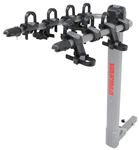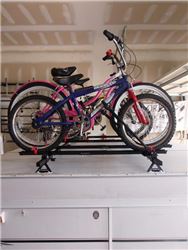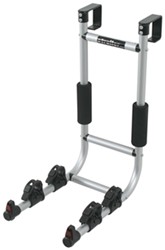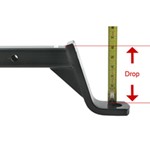How to Choose a Bike Rack for a Fifth-Wheel or Pop-Up Camper

Being able to bring bikes along on a camping trip can help turn a good trip into a great trip. There are a number of different ways to carry bikes along while towing a camper, and the best option will depend on the type of camper. Some bike rack options will work with all types of trailers, while others are only compatible on one. Carrying the bikes on the roof of a pop-up camper is a great solution, but this set-up wouldn't work well on a 5th wheel camper. A bumper mounted bike rack works well on campers with larger bumpers, such as 5th wheels and travel trailers, but these racks aren't designed to fit smaller pop-up camper bumpers. Check out the different options for carrying bikes to see which one works best with your trailer and towing set-up.
Shop By Trailer Style
How Can I Carry My Bikes?
- Hitch Mounted Bike Rack
- Front Mount Hitch Bike Rack
- Tow Vehicle Roof Bike Rack
- Bumper Mounted Bike Rack
- Ladder Mounted Bike Rack
- Ball Mount Bike Rack
- Truck Bed Bike Rack
- Tongue Mount Bike Rack
- Camper Roof Rack
Hitch Mounted Bike Rack


When looking for a hitch bike rack to mount on a trailer, it is important to make sure the bike rack is approved by the manufacturer for RV/trailer use. This is to ensure that the rack can stand up to the force exerted on it at the back of the trailer. Hitch mounted racks are available to carry up to 4 bikes at the back of the camper. The biggest benefit to using a hitch mount bike rack is that it can also be used on the tow vehicle when the trailer isn't attached. After setting up the trailer at the campsite, a hitch bike rack can be transferred to the truck and the bikes can be driven to the trailhead.


Need a trailer hitch?
There are a couple of options when it comes to choosing a trailer hitch receiver for a camper trailer. The hitch receiver can either be mounted to the trailer bumper or installed on the trailer frame. The durability of the trailer bumper and the width of the frame are factors that will determine which hitch type is best suited for your camper. If the bumper is not designed to carry additional weight or it is not reinforced, a frame mount hitch receiver is the way to go. A bumper mounted receiver typically requires a continuous welded steel bumper, most often measuring 4 inches x 4 inches.
Front Mount Hitch Bike Rack


If the tow vehicle has a front mount hitch, a standard hitch mount bike rack can be used to carry bikes on the front of the tow vehicle. Some people prefer to carry bikes on the front of the vehicle so the bikes can stay in view from the truck cab. The things to keep in mind when carrying bikes on the front of the vehicle are to make sure the bikes won't block the headlights when driving at night and to make sure the airflow to the radiator isn't limited by the bikes. When not towing your camper, a hitch bike rack can be carried in the rear hitch of the vehicle to take the bikes to the trailhead.
Tow Vehicle Roof Bike Rack


A roof rack allows bikes to be carried on the roof of the tow vehicle. Much like hitch racks, a roof rack will also allow the transportation of bikes when not towing a trailer. Roof mount racks are a great solution when a variety of bikes are coming along on the trip. With a roof rack, each bike can have the best style rack for the bike's style. One thing to keep in mind when carrying bikes on your tow vehicle's roof is the height of your vehicle. The height of the newer model pickup trucks can present a challenge in mounting the bike racks. To help reach the top of your tow vehicle, running boards, a tire step, or a step stool can be helpful.



Bumper Mounted Bike Rack


If you don't want to install a hitch receiver on your trailer, a bumper mounted bike rack is a great option. These racks use U-bolts or mounting plates to clamp around the travel trailer or 5th wheel's bumper. Bumper mounted bike racks are available in both hanging and platform style racks. It is important to make sure your trailer's bumper can handle a bike rack. A bumper mounted bike rack typically requires a continuous welded steel bumper, most often measuring 4 inches x 4 inches. Aluminum or spot welded trailer bumpers are usually not strong enough to handle the weight of a bike rack and bikes.


Ladder Mounted Bike Rack


If your camper has a rear-facing ladder, a ladder bike rack is another option for carrying bikes. Ladder mounted bike racks offer the capacity to carry 2 bikes. The bikes are carried vertically and supported by the frame member between the seat post and the pedals. These bike racks are great for lightweight bikes or children's bikes.


Ball Mount Bike Rack


Another way to carry bikes between the tow vehicle and the trailer is to use a bike rack that mounts onto the ball mount. These style bike racks have either a built-in ball mount or will mount around a 2 inch ball mount shank. These bike racks are available in both hanging and platform style bike racks and are made to accommodate from 2 to 4 bikes. Keep in mind however, with 3 or more bikes on this style rack turning clearance could be limited.



Truck Bed Bike Rack


When towing with a pickup truck another option for carrying your bikes is in the pickup bed. There are a number of different options to carrying bikes in the truck bed, such as fork mount racks, frame mount racks, wheel mount racks, and tailgate pads. Between these bike rack options, there is a rack to fit nearly every bike and every truck bed.


Tongue Mount Hitch Rack


Another way to tow your bikes is with a tongue mount hitch rack, like the Stromberg Carlson Bike Bunk. Tongue mount hitch racks allow the bikes to stay in view without blocking the front of the vehicle. Some tongue mount racks install around the A-frame of the trailer, while others, like the Jack-It, mount with the A-frame jack. The important thing to keep in mind with this style is its weight capacity. Each rack varies, but typically this style mount requires that the weight of the bikes and bike rack total no more than 100 pounds. Some tongue mount hitch racks also require that the bike rack used be approved for use on a trailer. If a bike rack is not included with the mount, we recommend using a lightweight, 2-bike rack, such as the Lets Go Aero BikeWing-2.

Camper Roof Bike Rack


Some pop-up campers come with a roof mounting system installed from the factory. For those that don't, an aftermarket roof rack can be added. A standard roof mounted bike rack works well on top of the pop-up to bring along everyone's bikes. Carrying the bikes on top of the pop-up works well to keep the overall height of setup lower than if the bikes were on top of the tow vehicle. Carrying the bikes on the pop-up also helps reduce the wind drag from the bikes because they are behind the tow vehicle. Typically the roof of the pop-up is lower than the roof of the tow vehicle, making it easier to load the bikes.


Related Products
Related Articles
Carrying Bikes While Towing a 5th Wheel Camper Trailer
Carrying Bikes While Towing a Travel Trailer
Carrying Bikes While Towing a Pop-Up Camper
Written by: Victoria B
Updated on: 5/8/2018
Departments
Towing
- Trailer Hitch
- Fifth Wheel
- Gooseneck
- Towing a Vehicle
- Front Hitch
- RV Hitch
- ATV Hitch
- HD Truck Hitch
- Vehicle Wiring
- Brake Controller
- Ball Mounts
- Weight Distribution
Sports and Recreation
Trailer Parts
- Utility Trailer
- Boat Trailer
- Landscape Trailer
- Enclosed Trailer
- 5th/Camper Trailer
- Car Hauler
- Horse Trailer
Vehicle
Contact & Help






































